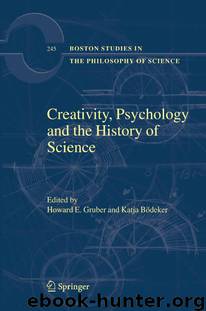Creativity, Psychology and the History of Science by H. Gruber

Author:H. Gruber [Gruber, H.]
Language: eng
Format: epub
Published: 2014-06-20T20:11:19+00:00
264
CHAPTER 4: MODALITIES
definition. We don’t want to surrender the hope of developing reasonable and precise models of how individuals function. But we don’t need to suppose that the model for one person will be the same as the model for another. This point applies to the use of metaphor as much as it does to any other aspect of creative functioning.
METAPHOR AND CONTEXT
Generally speaking among psychologists and philosophers, but not among literary folk, metaphor is discussed in the singular and with a capital M: What is Metaphor? What is Metaphor really? Examples are chosen here and there to suit particular theoretical purposes as though the essence of metaphor can be captured in a singular key example, or two essences can be captured in two key examples. That’s true of the book edited by Ortony, which is both an influential book and a good expression of the state of the art, at least as it was a few years ago. In his introduction, Ortony promises that the second half of the book will be devoted to how metaphors work in text, in a context, in a live protocol. But, I think it is fair to say, that never happens in the book.
In the quest for simplicity, which is the hallmark of the experimental method, many investigators of metaphor have reduced the stimulus material to the barest minimum. In a nominative metaphor, for example, the minimum is three components: noun phrase, copula, noun phrase—as in “surgeons are butchers” (taken from Camac and Glucksberg 1984).
In this minimal form, as a number of investigators suggest, it is tempting to argue that the essence of metaphor lies in the conceptual similarity of tenor and vehicle.
Moreover, in a number of studies, conceptual similarity has been taken to mean prior association of the terms (Johnson and Malgady 1979). Camac and Glucksberg point out one of the failings of this “prior association hypothesis,” namely that it ignores the different functions of tenor and vehicle. Conceptual similarity of two terms is not affected by their order, but the metaphor “my surgeon is a butcher” is quite different from “my butcher is a surgeon.” The underlying context that makes both of these metaphors comprehensible is probably a set of occupational norms: in one case the metaphor means that the surgeon is below the norm for surgeons; in the other case that the butcher is above the norm for butchers; and that the norm for surgeons is in some ill-defined way higher than the norm for butchers. Thus the order effect depends on an implicit context. In the same article Camac and Glucksberg also point out that quanti-fiers should have no effect on conceptual similarity, but that they do have an effect on the meaning and plausibility of metaphors. Thus, “some psychologists are torturers”
seems more plausible than the unquantified version, “Psychologists are torturers.”
(Likewise for “generals are murderers”?)
McCabe (1983) has shown that if context is reduced to a bare minimum, conceptual similarity is an influential variable in determining the effectiveness of metaphors.
When
Download
This site does not store any files on its server. We only index and link to content provided by other sites. Please contact the content providers to delete copyright contents if any and email us, we'll remove relevant links or contents immediately.
Whiskies Galore by Ian Buxton(41797)
Introduction to Aircraft Design (Cambridge Aerospace Series) by John P. Fielding(33044)
Rewire Your Anxious Brain by Catherine M. Pittman(18529)
Craft Beer for the Homebrewer by Michael Agnew(18122)
Cat's cradle by Kurt Vonnegut(15149)
Sapiens: A Brief History of Humankind by Yuval Noah Harari(14209)
Leonardo da Vinci by Walter Isaacson(13145)
The Tidewater Tales by John Barth(12595)
Thinking, Fast and Slow by Kahneman Daniel(12021)
Underground: A Human History of the Worlds Beneath Our Feet by Will Hunt(11996)
The Radium Girls by Kate Moore(11897)
The Art of Thinking Clearly by Rolf Dobelli(10173)
A Journey Through Charms and Defence Against the Dark Arts (Harry Potter: A Journey Throughâ¦) by Pottermore Publishing(9209)
Mindhunter: Inside the FBI's Elite Serial Crime Unit by John E. Douglas & Mark Olshaker(9158)
Tools of Titans by Timothy Ferriss(8184)
Wonder by R. J. Palacio(7973)
Turbulence by E. J. Noyes(7918)
Change Your Questions, Change Your Life by Marilee Adams(7609)
Nudge - Improving Decisions about Health, Wealth, and Happiness by Thaler Sunstein(7538)
